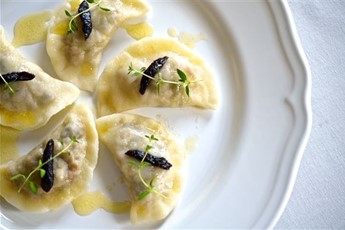Polish shop food specialities

Fancy trying something new? Why not pick up something from your local Polish shop?
Thanks to its rich, varied and often troubled history, Polish cuisine has been heavily influenced by a number of different cultures and nations.
There are lots of different dishes you might want to try, and thanks to an abundance of Polish shops (Polski Sklep) now in the UK, you can fairly easily get hold of the ingredients.
There aren’t as many Polish restaurants in Britain as you might expect, but this is perhaps a reflection of the fact that many dishes are home-cooked family favourites.
Generally speaking, dishes are pretty heavy and hearty – it’s unlikely you’ll feel hungry after settling down for a traditional Polish dinner.
So take a look at some of the following popular dishes to find something which appeals and stock up on ingredients to prepare these dishes in your own kitchen.
Kielbasa
Pretty much a staple of Polish cuisine is the sausage, or Kielbasa (pictured above). There are dozens of different varieties, and some even have protected geographical indication (PGI) status, meaning they can only be produced in a certain area.
While Kielbasa is the general name for any kind of sausage, look out for specialities including kabanosy (a thin pork sausage flavoured with caraway seeds), krakowska (named after the city of Krakow – a thick sausage smoked with pepper and garlic) or kaszanka (a traditional blood sausage).
You can find kielbasa served on its own, garnished with some fried onions, or as part of other dishes including zurek (a type of soup).
Pierogi

These days, pierogi is considered to be the Polish national dish. They can either be boiled, fried or baked in the oven depending on the type of finish you want – and it’s even possible to find or make a sweet variety of pierogi.
Placki ziemniaczane
A very filling dish, placki ziemniaczane are potato pancakes or fritters, which are often served with stew or casserole-type dishes such as goulash. Made with grated potatoes fried in fat, other ingredients such as egg, onion and spices can be added before frying to create different flavours.
Zurek
 A traditional soup often served at Easter, you should still be able to find zurek in Poland throughout the year. Occasionally it is served in an edible bowl made from potatoes or bread, and the exact recipe will vary depending on the region you’re visiting.
A traditional soup often served at Easter, you should still be able to find zurek in Poland throughout the year. Occasionally it is served in an edible bowl made from potatoes or bread, and the exact recipe will vary depending on the region you’re visiting.
Generally, it is made with sour rye flour and meat (usually kielbasa, or perhaps bacon or ham) and sometimes a hard-boiled egg will be placed on top of the meat.
Kotlet schwabowy
Pork is probably the most prevalent meat in Polish cuisine, and these cutlets coated in breadcrumbs and fried are pretty similar to the German schnitzel. Generally served with potato, or a variant of, you may also find them with vegetables such as cabbage.
Bigos
 Eaten regularly by tourists, considered by many to be another national dish of Poland, bigos translates as “hunter’s stew”. A very slow-cooked stew, the main ingredient, as with lots of Polish cuisine, is cabbage. Added to this, you’ll find ingredients like sausage, mushrooms or onion, and a collection of spices which generally stays the same (bay leaf, pepper, allspice). Sometimes wine will be added.
Eaten regularly by tourists, considered by many to be another national dish of Poland, bigos translates as “hunter’s stew”. A very slow-cooked stew, the main ingredient, as with lots of Polish cuisine, is cabbage. Added to this, you’ll find ingredients like sausage, mushrooms or onion, and a collection of spices which generally stays the same (bay leaf, pepper, allspice). Sometimes wine will be added.
This kind of stew is served with bread or potatoes, and will often be the first course of a meal, rather than the main event.
Pyzy
These potato dumplings can be stuffed with meat (of course) and will often be found inside other bigger dishes.
Are you a fan of Polish food? Can you make any more recommendations for what to buy? Share them in the Comments below.
You might also like:
Prune dumplings (pierogi) recipe
Comments
Be the first to comment
Do you want to comment on this article? You need to be signed in for this feature